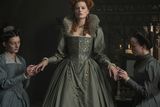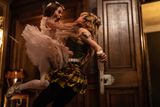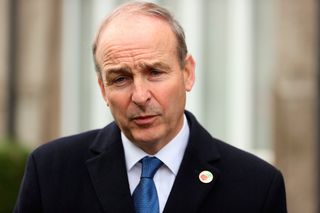Killer queen: the true story of Mary, Queen of Scots
Naive political ingenue, or tragic victim of the patriarchy? As Saoirse Ronan reimagines Mary Stuart in her new film, Liadan Hynes looks at the truth behind the legend of the Scottish queen


'In my end is my beginning," Mary Stuart famously embroidered shortly before her brutal death by beheading in 1587.
It was a reference to what the devoted Catholic saw as her impending spiritual immortality, but little could she know that over 400 years after her death in 1587, her legend would still live on, enduringly capable of fascinating. Most recently, she has been reimagined in Saoirse Ronan's latest film, Mary Queen of Scots, to be released later this month.
Mary was the great-niece of Henry VIII, he of the six wives and father to her cousin, the future Queen Elizabeth I. The two girls had wildly different formative years. Elizabeth, the elder by nine years, was an instant disappointment to her father, on account of her gender. Ironic, given the mettle she would later display as a ruler. Her mother, Anne Boleyn, was executed when the child was not yet three, and Elizabeth was instantly demoted from the status of Princess, deemed illegitimate, and sent away from court until she became queen at the age of 25.
Mary, on the other hand, was named Queen of Scotland at just six days old, in December 1542, when her father, King James V, died of a fever. A female ruler wasn't a prospect that delighted all of Scotland at that time. It is speculated that the possible threat this might pose to her young daughter's safety was what caused her mother, Mary of Guise, to send her child to live with their powerful relatives at the court of France.
One of the Sheffield House portraits of Mary, who was the great niece of Henry VIII
The actions of Henry VIII of England at this time were probably also a contributing factor; in an effort to wed the young queen to his son, he engaged upon what became known as the Rough Wooing - a war between Scotland and England.
Safe in France at the court of King Henry II, Mary enjoyed a cultured, luxurious upbringing, probably quite different from the one she might have experienced at the less salubrious Scottish court. She learnt to dance and hunt, very successfully in both cases, wrote poetry, and enjoyed a varied education, covering Latin, Italian, Spanish and Greek.
Mary's beauty is the one undisputed aspect of her legend. Unlike her cousin Elizabeth, who courtiers knew to flatter at the expense of all other women, Mary seems to have been a genuine beauty. Unusually tall for the time (five foot 11), she was slender, with clear pale skin and red/gold hair. Both cousins took great care in maintaining their complexions; Elizabeth using white chalk-like make-up made of lead and vinegar (used to cover the scars of smallpox, it is thought to have had a poisonous effect), Mary using white wine. In 1558 she married King Henry II of France's eldest son, the Dauphin Francis.
Life must have seemed secure then to the young Mary. After a tumultuous start, her fate was sealed in this dynastic marriage to a young boy she was said to have been fond of, although history deems the marriage unconsummated.
Later that same year, her cousin Elizabeth became Queen of England, an event which made Mary next in line to the English throne. In the eyes of many English Roman Catholics, Elizabeth was illegitimate. By this reasoning, Mary was in fact now the rightful queen of England. It was a state of affairs which did not recommend the Scottish royal to her cousin, a woman who spent a lifetime fixated on solidifying the legitimacy of her claim to the throne.
The two queens had varying levels of success as women ruling in the most patriarchal of societies. Elizabeth built her power on her idea of being the Queen Bee at court, seemingly using her female-ness as a source of strength. Where womanhood was a boon for the English Queen, for Mary, repeatedly used by others as a pawn, it was a bane.
The traditional interpretation of the pair is of Elizabeth as a cold, calculating, natural politician; sexless, ruthless. The Virgin Queen, disgusted by Mary's sexual antics. Mary, in this telling, is painted as a passionate, sexual, loving creature, politically naive. One ruled with her head, the other her heart. Where Elizabeth was the original stateswoman, Mary was a frivolous fool. Or, if you are Catholic, then the former was a heartless conniver, the latter a wronged martyr. More recent interpretations, particularly that of biographer John Guy, whose book My Heart is My Own: The Life of Mary Queen of Scots, was the source material for the new film, would suggest that it was bad luck rather than lack of political nous that brought about her demise.
Mary's father-in-law, King Henry II of France, died in 1559, making her husband the king, and she the queen consort. Tragically, Francis died in 1560, and the following year, now a widow, the 18-year-old Mary returned to Scotland. Like Elizabeth, who took up to four hours to get dressed, Mary understood the need to dress for the part of Queen. She travelled in a fleet of 12 ships. One carried Mary and her ladies-in-waiting, a second her cooks, grooms, maids and servants. The further 10 ships bore the Queen's possessions, furnishings, her wardrobe, jewellery, pets, and furniture, including 45 beds.
Things on her return were not straightforward. Scottish nobles were a fractious, quarrelsome bunch. "I am their queen and so they call me, but they use me not so," she complained at this time. In her absence, Scotland had adopted Protestantism as its official religion. This put Mary, a devout Catholic, and essentially a foreigner, in a difficult position. Elizabeth refused to name her heir of the English throne, further weakening her position. Despite the inauspicious circumstances of her return home, Mary reigned successfully for the first few years, due in part, possibly, to her oft-referenced charm. She herself had strongly held Catholic beliefs, but as a ruler was, like her cousin, tolerant of others' spiritual persuasions. Five years after arriving home, she married again, this time to her cousin Henry Stuart, Earl of Darnley. It is this event that her biographer, Antonia Fraser, marks as the starting point of the "fatal train of events" that would lead to her demise. Fraser describes the marriage as a reckless act on Mary's behalf; she married for love. Mary herself later described her new husband as the "lustiest and best proportioned" man she had ever seen. Said to have been handsome, and at six foot unusually tall for that era, Darnley was recorded by Mary's courtiers as arrogant and petulant, a weak-natured womaniser capable of great cruelty, who was a heavy drinker.
The marriage was a tumultuous affair. On March 9, 1566, the Queen and a group of close associates were having supper in a room off her bedroom, when Darnley, accompanied by a group of armed noblemen, burst into the small room and accused David Rizzio, the Queen's Italian private secretary and close confidant, of having an affair with her. Mary was then six months' pregnant, and reports have it that during the fracas a pistol was aimed at her stomach. Rizzio was murdered before the eyes of the pregnant Queen, the men stabbing him over 50 times.
Saoirse Ronan as Mary Queen of Scots
Later that year, Mary gave birth to a much-longed-for son, James, the heir to both the English and Scottish thrones. The line secured, it seemed that her troublesome husband's usefulness was entirely at an end. Critics of the Queen claim it was now that an adulterous relationship between Mary and James Hepburn, Earl of Bothwell, began, with accusations that the pair planned her husband's murder, claims bolstered by letters allegedly sent between the lovers, letters now proved to be fake.
On February 10, 1567, when their son James was one year old, Darnley's house just outside of Edinburgh was blown up, and Darnley strangled while trying to escape. In fact, history would suggest that Mary herself was not involved in the plot that killed her husband, but her lack of urgency in subsequently hunting down his killers was enough for her critics. What happened next remains open to interpretation.
Mary married the chief suspect in her husband's death, Bothwell, three months after Darnley died, but accounts of the events leading up to that marriage differ. In April, on her way to Edinburgh, the Queen was met by Bothwell, accompanied by a force of 800 men. He declared that there was trouble in the city, and that he was taking the queen under his protection. As a woman, what else could she do, writes Kate Williams, whose book Rival Queens: The Betrayal of Mary Queen of Scots argues that Mary's gender was the defining factor of the events of her life. Accounts describe how once at his residence, Bothwell, who could be described as having abducted the queen, "ravished her and laid with her against her will".
Raped her, in other words.
Mary now became the most famous, if most terminally undiagnosed, case of victim blaming. It was widely thought that she did not protest at Bothwell's unlooked for attention, and that in fact given her sexual proclivities she most likely welcomed it. Asking for it, to use modern-day parlance.
That she went on to marry him was used as further proof of her wanton ways. In fact, there is a suggestion the Queen was pregnant with twins she went on to miscarry. Williams points out that marrying Bothwell was the only means by which Mary could dissipate the shame of rape and possible pregnancy.
Scottish nobles had disliked Darnley, but neither did they favour Bothwell, the Queen's third husband. The pair were separated on June 15, 1567, and Mary was forcefully deposed, her one-year-old son declared king, and his mother imprisoned on the small island of Loch Leven. She escaped, but the army she put together was defeated, and she was forced to flee.
She ran to England, to Elizabeth. "Be as my sister," Mary had begged her cousin in letters, and she no doubt expected the English Queen's full support. Instead, Elizabeth, who ruled until her death aged 69, and who never saw Mary as anything other than a threat to her own security on the throne, imprisoned the Scottish Queen for the next almost two decades, until her cousin's death.
Williams describes Mary's life until her execution as wasting away in a gilded cage. She was allowed to order clothes and furniture from Paris but the days were long and dull, and her movements highly restricted.
There was her religious practise, embroidery, and her dogs. Her beauty waned, lack of physical exercise meant she lost her famously sylph-like figure. Always a sufferer of bad health, by the end it seems walking had become difficult. Pleas and plots against her cousin took up much of her time, it is said.
In 1586 a plot to kill the Queen and stage a Catholic uprising was discovered. Elizabeth seized the chance to get rid of Mary, this lingering threat to her rule. Reluctant to decree the death of a fellow queen, she had her cousin tried by the English parliament. Mary's son, now with hopes of his own of succeeding Elizabeth, did not object. After her death, her son, then King James I of England, ordered a huge monument built for his mother at her tomb in Westminster Abbey.
In 1587, Mary, aged 44, was executed after being found guilty of plotting the murder of her cousin. "This bewitching Princess... abandoned by her son, confined, by her cousin, abused, reproached and vilified by all... firm in her Mind, Constant in her Religion; & preparing herself to meet the cruel fate to which she was doomed, with a magnanimity that could only proceed from conscious Innocence," Jane Austen wrote of the Queen of the Scots.
Descriptions record Mary as showing huge dignity at her execution. "You will do me much good in withdrawing me from this world, out of which I am very glad to go," she said at the time. Approaching the block "cheerful and smiling" according to witnesses, she cast off her black gown to reveal a red dress underneath, the shade of Catholic martyrdom. It took her executioner several attempts to actually decapitate the Queen. Lifting her head aloft, to his shock it fell to the ground and rolled away, leaving him grasping just a red wig. Mary was an animal-lover, and at her execution, her small terrier dog ran from where it had hidden in her skirts, howling desolately. He refused to leave his mistress's side and, legend has it, broken-hearted, he died shortly afterwards.
Margot Robbie stars as Queen Elizabeth I in MARY QUEEN OF SCOTS
Join the Irish Independent WhatsApp channel
Stay up to date with all the latest news

















